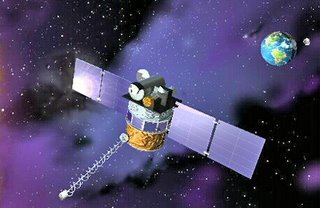Desmog Blog readers know how much cyber-ink we have spilled trying to save the Deep Space Climate Observatory (DSCOVR). Our work may finally be over.
The Omnibus Appropriations Bill 1105, just passed yesterday by the US Congress contains the following fateful statement on page 141:
WOW!
Details remain sketchy but it seems that the loony idea to strip the spacecraft of all Earth observing instruments has gone by the wayside.
More importantly, the passage of this bill means that DSCOVR may finally be on its way into space where it will return vital data about our warming world.
To recap, this fully completed $100 million climate observing spacecraft has so far sat in a box in Maryland for the last eight years. Dr Robert Park summed up the feeling of many in the scientific community when he described DSCOVR as “the most important thing we could be doing in space right now”.
Why? DSCOVR would gaze back towards Earth from the unique vantage of one million miles towards the sun – an entirely new way of doing space-based research.
While much remarkable science continues to be done from low Earth orbit, it is like trying to map an elephant using a microscope. Being so close to our planet means most satellites only see the Earth in thin strips, and vital numbers relating to climate change still do not add up.
After spending billions of dollars, researchers remain unable to close Earth’s outgoing radiation budget closer than 6 watts per square meter – that “noise” in the data is almost six times larger than the effect of climate change we are trying to see.
DSCOVR would instead see Earth from almost 1,000 times farther away with a continuous view of the entire sunlit side of our planet. This would provide DSCOVR much more accurate data on our planet’s changing albedo – a vital measurement to resolve the energy budget of our planet. DSCOVR would also better calibrate billions of dollars of space hardware now in low Earth orbit.
More importantly, DSCOVR would for the first time allow us to directly measure global warming – something that is routinely questioned by so-called “skeptics”. One would think resovling such weighty issues would be a scientific priority but this mission has been mired in politics from day one.
First there was the partisan political reaction to Al Gore’s promotion of the project in the 1990’s. Then perhaps some office politics within NASA. Let’s not forget Bush’s meddling in the mandate of NASA.
Yet the mission was so important to the scientific community that both Russia and France offered to launch the spacecraft themselves. The answer from NASA? No thanks.
Another US agency wanted the mission transferred to them. The answer from NASA? No Thanks.
Numerous Freedom of Information requests were made by Desmog Blog to NASA, NOAA, and the Whitehouse to try and get to the bottom of this mystery. These dragged on months beyond legal timelines and virtually all internal documents were withheld.
NASA brass may also have misled the media about the true costs of launching DSCOVR.
Meanwhile the scientific community rallied support for the mission, outraged that such a vital experiment could be built and then discarded for political reasons. Some of these researchers have seemingly made it their life’s work to see this mission completed, working tirelessly behind the scenes to overcome political and funding roadblocks.
Progress was slow and fitful.
Last year, Congress ordered NASA to come up with a plan to deal with DSCOVR with 180 days (deadline is this April).
Then came word of a bizarre plan where NASA would give the spacecraft to Air Force, after stripping it of all Earth observing instruments. This might have provided a convenient way to satisfy the legal requirement to Congress, while ensuring that the spacecraft would be useless for what it was designed to do: measuring the energy budget of our warming world.
Last year, Desmog Blog shared some remarkable revelations from a NASA insider, including that the project may have been killed by Dick Cheney personally.
We were also contacted by the prestigious journal Nature, which later ran a story on the mired mission.
Why has there been such resistance to launching DSCOVR – a spacecraft fully completed at a cost of more that $100 million? In the absence of documents (which so far have been denied through freedom of information), we can only speculate but the politics of oil cannot be far from this bizarre story. Rest assured, I will keep digging.
Thankfully, the drama seems to be drawing to a close. The nation is under new management and we are hopefully entering a political landscape that is not as pathologically hostile to climate science.
The many dedicated scientists that never gave up on this vital experiment must be heartened by this week’s events. DSCOVR is still a long way from flying into space – the $9 million is only to refurbish the Earth observing instruments, not to launch or operate the mission. The bill must also pass the Senate.
That said, what just happened in Washington might finally be the turning point in a long fight to save the spacecraft that could save the world.
To see all the DSCOVR posts, they are available here.
This month we’re giving away FREE copies Nobel Laureate Dr. Andrew Weaver’s new book Keeping Our Cool: Canada in a Warming World.
Go here to find out more details about DeSmogBlog’s monthly book give-away.
Subscribe to our newsletter
Stay up to date with DeSmog news and alerts






